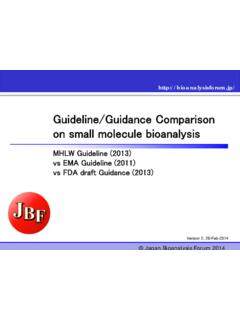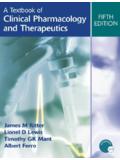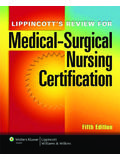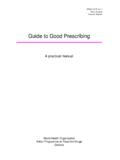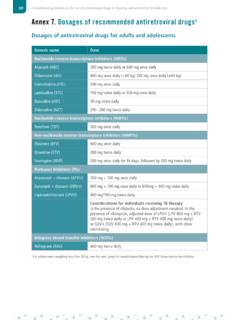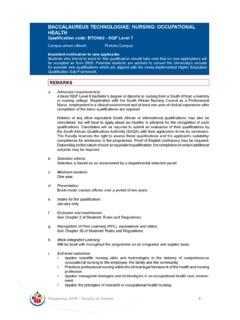Transcription of The EMA Bioanalytical Method Validation …
1 The EMA Bioanalytical Method Validation Guideline: process , history , discussions and evaluation of its van Amsterdamon behalf of EBFP resented at:2nd JBF meeting9 March 2012, EMA processes2. EBF interactions3. Content guideline4. Points of attention5. References08-Mar-122 Part 1: EMA processes BMV Guideline: Dates & 18-Dec-2008 Concept paper/recommendations on the need for a (CHMP) guideline on the Validation of Bioanalytical methods pdf 19-Nov-2009 Draft. Guideline on the Validation of Bioanalytical methods .pdf 21-Jul-2011 Guideline on the Validation of Bioanalytical methods pdf 21-Jul-2011 Overview of comments received on Guideline on the Validation of Bioanalytical methods BMV Guideline: who, why & how Rapporteur: Netherlands Co-Rapporteur: France Inspectors EMA: no Bioanalytical guideline available New BE guideline with a section on Bioanalytical methods ICH/FDA/current scientific Medicines Agency (EMA)Bulgaria Austria France Latvia Poland Belgium Germany Liechtenstein Portugal Cyprus Greece Lithuania Slovak Republic Czech Republic Hungary Luxemburg Slovenia Denmark Iceland Malta Spain Estonia Ireland The Netherlands Sweden Finland Italy Norway United Kingdom - European Medicines Agency CHMP - Committee for Human Medicinal Products1 Member/Member State (n=27)1 Alternate/MS 1 Member from Iceland & Norway5 Co-opted partyEWP(efficacy working party)CMDhsub- groupPKsub- groupCommittee for Human Medicinal the Bioanalytical groupPK EWPEU PK assessorsQWPPK EWPEWPCHMPP ublished draftEWP08-Mar-129 paper/recommendations on the need for a (CHMP)
2 Guideline on the Validation of Bioanalytical methodsPROBLEM STATEMENT The CHMP does not have a Note for Guidance on Validation of bio-analytical methods , although analytical methods and validations are included in most application dossiers. The new guideline will provide recommendations for the Validation of a Bioanalytical Method . Next to that, specific topics should be addressed with regard to the Bioanalytical Method , the actual analysis of study samples. Furthermore it is not the purpose of the new guideline to introduce fully new criteria, but it should be in line with current scientific knowledge on this topic. Bioanalytical guideline: 07 Sept08!!Dec 08 July 09 July 09 Oct 09 Nov 09 Dec 09 CPD1D2D3D4D5D6D7 Pub- lisheddraftPK EWPPK EWPPK EWPPK EWPTCPK EWPEWPCHMPQWPD8D9 EWP08-Mar-1212 - Guideline on Validation of Bioanalytical methodsSCOPE This guideline provides requirements for the Validation of Bioanalytical methods .
3 In addition, specific aspects of the Bioanalytical Method itself will be addressed, the actual analysis of samples from toxicokinetic studies and clinical trials. Furthermore, this guideline will describe when partial Validation or cross Validation may represent an appropriate alternative approach to the complete Validation of an analytical Method . Some special techniques such as radio-labelled analysis methods using 14C labelled drugs, are not covered here, but even in such cases efforts should be made to apply to the principles of this draft to final: Consultation period Comments received from > 50 sources Informal and formal contacts with FDA, under confidentiality agreements Discussions at workshops, EBF 2nd open symposium: Barcelona, Dec 2009 EBF/EUFEPS workshop: Brussels, April 2010 CVG 4th WRIB: Montreal, Apr 2010 EBF symposium @NBC: San Francisco, May 2010 BFG Symposium @AAPS: New Orleans, Nov 2010 EBF 3rd open symposium: Barcelona, Dec 2010 on Bioanalytical Method validationScope This guideline provides recommendations for the Validation of Bioanalytical methods applied to measure drug concentrations in biological matrices obtained in animal toxicokinetic studies and all phases of clinical trials.
4 As ligand binding assays differ substantially from chromatographic analytical methods , separate Validation recommendations for ligand binding assays are provided. In addition, specific aspects for the analysis of study samples will be addressed. Furthermore, this guideline will describe when partial Validation or cross Validation should be carried out in addition to the full Validation of an analytical Method . methods used for determining quantitative concentrations of biomarkers used in assessing pharmacodynamic endpoints are out of the scope of this 2: EBF activities Concept paper (Dec 2008) Jan 2009 discussions during closed meeting Jan-Feb 2009 collect comments from members Mar 2009 provide EBF comments to EMA Dec 2009 session during 2nd EBF open symposium Draft guideline (Dec 2009) Jan-Feb 2010 collect comment from members Apr 2010 EBF/EUFEPS workshop May 2010 symposium at NBC 2010 May 2010 provide EBF comments to EMA Dec 2010 GBC session at 3rd EBF open symposium Final guideline (Jul 2011) Aug-Oct 2011 collect comments from members Nov 2011 session at 4th EBF open symposium Mar 2012 discussion on implementation at EBF closed workshop 2012 problem solving do a surveyFDAEBF ConsolidatedCompany 1 Company 2 Company 3 Company 4 Company 5 Company 6 Company 7 Company 82.
5 PROBLEM STATEMENTno CHMP Note for GuidanceFurthermore it is not the purpose of the new quideline to introduce fully new criteria, but it should be in line with current scientific knowledge on this topicFully agreed. FDA BMV & CCIII AAPS paper are "the golden standards" accepted and implemented by the Bioanalytical society. 3. discussion applicationThe Note for Guidance on the Validation of Bioanalytical methods will apply to Marketing Authorisation Applications for human medicinal products submitted in accordance with the Directive 2001/83/EC as amended, in which the analysis of drug concentrations is part of the to chapter I. of FDA/CDER guidance : INTRODUCTION OK with EMEA statement, with exceptions : 1) It should be clearly stated if guidance applies to both chromatographic assays and LBAs or not, and if metabolite quantitation according to MIST is included 2) No Validation is required for non standard matrices like tissue homogenates, urine, rare matrics.
6 In these cases Method qualification, focussing on key scientific challenges for the particular matrix will suffice. The decision to follow this approach should be documented a to chapter I. of FDA/CDER guidance : INTRODUCTION OK with EMEA statement, with exception: no full Validation is required for non standard matrices such as tissue homogenates or rare matrices. In these cases Method qualification, focusing on key scientific challenges for the particular matrix will suffice. The decision to follow this approach should be documented a priori. Blood, serum, plasma, or urine are considered standard guidance is also applicable for veterinary drug approval; EMEA guidance too or will there be a separate guidance for that? refer to chapter I. of FDA/CDER guidance : INTRODUCTION OK with EMEA statement; Exception : no full Validation is required for tissue homogenates or rare as J&J, for early and exploratoy PD studies in animals fit for use approach should be applicable, in general the FDA 2001 and CCIII are not that bad, proposal stay as close as possible but try to make the european point wherever it is needed and gives some benefitGood Laboratory Practice (GLP).
7 The analytical laboratory conducting pharmacology/toxicology and other preclinical studies for regulatory submissions should adhere to FDAs Good Laboratory Practices (GLPs)5 (21 CFR part 58) and to sound principles of quality assurance throughout the testing process . The Bioanalytical Method for human BA, BE, PK, and drug interaction studies must meet the Method development and Validation , as well as the Bioanalytical part of clinical studies fall outside the scope of GLP. Method Validation has to be done in compliance with regulatory guidelines (FDA BMV amended by AAPS paper, EMEA). To assure quality the Bioanalytical laboratories should have written SOPs describing the Validation procedures and Validation as well as Bioanalytical part of clinical studies should be conducted according to a study protocol. The analytical laboratory conducting pharmacology/toxicology and other preclinical studies for regulatory submissions should adhere to FDAs Good Laboratory Practices (GLPs)5 (21 CFR part 58) and to sound principles of quality assurance throughout the testing process .
8 The Bioanalytical Method for human BA, BE, PK, and drug interaction studies must meet the criteria in 21 The Validation of Bioanalytical methods should be carried out in accordance with the principles of GLP to assure the quality and integrity of Bioanalytical data. However, as such studies fall outside the formal scope of GLP, the sites conducting the studies are not required to be certified as part of the GLP compliance certification scheme. Statement in EMEA BE document seems appropriate:The Bioanalytical part of bioequivalence trials should be conducted according to the principles ofGood Laboratory Practice (GLP). However, as such studies fall outside the formal scope of GLP, thesites conducting the studies are not required to be certified as part of the GLP compliance certificationopportunity to make more clear where GLP is applicable and what quality system is considered appropriate for clinical bioanalysisThe analytical laboratory conducting pharmacology/toxicology and other preclinical studies for regulatory submissions should adhere to FDAs Good Laboratory Practices (GLPs)5 (21 CFR part 58) and to sound principles of quality assurance throughout the testing process .
9 The Bioanalytical Method for human BA, BE, PK, and drug interaction studies must meet the criteria in 21 No GLP should be applied to Method development and Method only for non-clinical safety, application of GLP princ ip le s to clin ic al is ; a lmos t sa me a s J &JMETHOD VALIDATIONC omplete Validation of an analytical methodReference standardsrefer to chapter III. of FDA/CDER guidance : REFERENCE STANDARD, supplemented with paragraph 8 from CCIII Vish paperrefer to chapter III. of FDA/CDER guidance : REFERENCE STANDARD, supplemented with paragraph 8 from CCIII Vish paper. Consider changing term "complete" Validation to "full" Validation which is the established term. refer to chapter III. of FDA/CDER guidance : REFERENCE STANDARD, supplemented with paragraph 8 from CCIII Vish paperOK to copy FDA guidanceOKok FDA; distinguish between anlayte and IS; include guidance for Large Molecules/Biologics where this is less straight forward as for small moleculesrefer to chapter III.
10 Of FDA/CDER guidance : REFERENCE STANDARD, supplemented with paragraph 8 from CCIII Vish paperOK with chapter III of FDA: use of certified reference standard incl. contentpurity is n ot su fficient!!"full" Validation rather than "complete" to copy FDA and CCIII paper, but not neededd for Method Validation (small molecules)SpecificityCriteria to ensure the quality and/or purity of the reference standards and possible internal standards will be provided in .the guidelineThe specificity of the assay methodology should be established using a minimum of six independent sources of the same matrix. For hyphenated mass spectrometry-based methods , however, testing six independent matrices for interference may not be FDA guideline uses the term selectivity, which is the ability of an analytical Method to differentiate and quantify the analyte in the presence of other components in the sample, as a fundamental parameters of the Validation .


